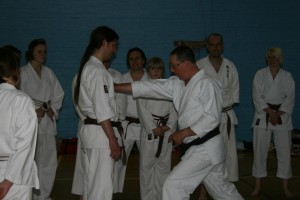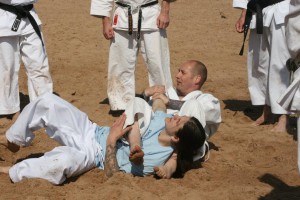Having recently attended the Traditional Shotokan Karate Association (TSKA) Residential Course (12th - 14th May), I thought I’d share my experiences with you.
Being my first time at the TSKA residential course, I wasn’t completely sure what to expect, though it was well recommended by my club-mates. So I turned up with high expectations and I have to say that I was not in slightest bit disappointed. The 3 main instructors for the course were Sensei Pete Manning 6th Dan, Sensei John Euden 5th Dan and my own instructor, Sensei Paul Mitchell 5th Dan.
Despite the 3 Sensei’s each having their own unique approach, each of them was very practical in their application to teach the art as an effective form of self defence rather than sport or just looking good.
Sensei Pete Manning began with basics, making it clear that not only are our basics the foundation on which all Karate is built, but that as Dan grades it is our responsibility (not only to ourselves, but to those we teach) to make sure that we keep our standards high and don’t get lazy.
As we had guests from other Shotokan Karate associations, Sensei Manning also made it clear that although some of the coming course content would be different from what some people had seen before, it was still within the Shotokan system. He explained that although some people train to a very high technical ability, they sometimes limit themselves to the grading syllabus which is not always the most effective method for surviving a real life street self defence situation.
This came into play later in the course when Sensei Manning took us through Jitte kata and it’s bunkai. The sequence of Age Uke’s (Rising Blocks) near the end of Jitte which are often explained simply as blocks to straight punches are clearly ineffective in that application. Firstly, why would you block one opponent, then turn to block somebody else. As Sensei Manning pointed out, what would the first opponent do after he’s been blocked then you turn your back on him to block somebody else. Of course they’re going to continue their attack.
Secondly, he explained that if you think our basics blocks (Rising Block, Outside Block, Inside block, etc) are just blocks, then try using them in sparring! Have one person attack with any basic techniques and the defender can only use full basic blocks (no parries or evasions). The defender will simply not stand a chance.

Instead, the Age Uke sequence at the end of Jitte was practiced as circular punches and elbow strikes which we used against focused mitts. Emphasis was also placed on using centrifugal force. I reminded myself as we practiced that Karate is largely based on Kung Fu (especially White Crane) which primarily relies on centrifugal force, rather than the linear force that most Karateka have become so familiar with. Despite the earlier emphasis on technical basics, with this exercise we were encouraged to use more natural stances, in particular the heal of the back foot could come off the floor rather the technical version of our basics where the heal stays down.
I reflected as we trained that although the methodology was a bit different between the technical basics and the applied version, they both had commonality. The technical version teaches us to rotate the hips (thus the erect spinal column) very fast. The applied version still used a rapid hip/spinal rotation, it just took it a bit further in more free flowing manner. Although some Shotokan Karateka may not have experienced this methodology before, I thought of the famous Funakoshi quote, “Learn various stances as a beginner but then rely on a natural posture”.
We also covered some releases from grabs, as well as some slightly unconventional (but nonetheless effective) strikes and take-downs from the opening sequence of Jitte.
Sensei Paul Mitchell continued on a similar theme with a combination of 2 crosses, upper cut and a devastating swinging back-fist strike. Again we used natural stances and centrifugal force. Emphasis was placed on striking right through the target. To do this we had to leave out the usual kime which Shotokan usually relies on. Sensei Mitchell reminded us that Funakoshi said that if you study the past to begin to understand the present. Whereas most Karateka think that looking back is to look at Okinawan Karate; Funakoshi (being Okinawan) would have looked back to Chinese martial arts on which the Okinawan Karate was largely based. The combination Sensei Mitchell had us doing was from a Chinese martial art, Chen Tai Chi. It nevertheless fitted in hand in glove with Shotokan, filling in some of the practicality gaps in Shotokan’s arsenal,when only trained on a technical level.

In later sessions, Sensei Mitchell took us through more conventional Shotokan punches, focusing on Gyaka Zuki (Reverse Punch) and Kizami Zuki (Extended Punch) with Suri-Ashi (Sliding Step). After solo practice to refresh the technique, we partnered up and used focus mitts to make sure that the techniques were delivering enough real power.
Sensei Paul Mitchell’s last session drew largely from his knowledge of Tai Chi and for those who hadn’t seen it before it was quite mind-blowing. Ki (Chi in Chinese) is internal energy and would have been a very important concept for the Okinawans as their martial arts were largely based around it. Many Westerners do not believe in Ki/Chi and that’s fine, but it may have have been how Funakoshi would have trained.
Several evasions and takedowns were practiced which relied on complete relaxation so that we could use ki energy. Although as Karateka we think we know how to relax in our technique, this session took it to a whole new level. This session was not really something that could be taken away and used in isolation as the concepts take years of practice, even for Karate Dan grades. However, it did give the students a taste of the higher levels and concepts of martial art that is waiting for them should they choose to follow that path. For anybody who would like to understand it a bit better, Sensei Mitchell is in the process of writing a book which will be worth looking out for once it is published.
Sensei John Euden was probably the most classical in his approach, but nevertheless just as practical in his application. His first session started with the kata Senka. This kata he explained was created by Master Asai, and although it is not taught in all Shotokan associations it is nevertheless a Shotokan kata. He recommended that we take it away and practice it to help keep it alive. For the uninitiated, Senka has a lot of spinning/circular movements, utilizing centrifugal force, so again fitted in with an overall theme.
Later we did some slightly unconventional combinations of basics which tested us mentally as well as physically. I was glad to see that I was not the only one who struggled a bit with them. We then partnered up and practiced various striking and blocking combinations which took even more concentration (especially if you didn’t want to get hit). This was great training for reactions and building speed.

Later we practiced sequences of blocks and strikes, leading into take-downs, wrist locks and arm locks. Some of these locks were excruciatingly painful, which in some strange way did seem to delight Sensei Euden 🙂
During some of the sessions with other instructors, several times we heard yells of pain coming from the intermediate grades that Sensei Euden was demonstrating on as he taught them alongside us.

Other highlights of the residential included the beach training and the party. The beach training has become a tradition now. The soft sand makes it ideal for practicing take downs and throws learnt in the other sessions without getting too many bruises, though the wrist locks still hurt just as much. You may get the odd mouthful of sand, but it does teach you when to keep your mouth shut!
Then somebody came up with the bright idea of going into the sea and training. OK, this was not a new idea and is also part of the tradition. So we went in up to about our wastes and practiced some punches and blocks. Some people, with encouragement from Sensei Mitchell, ducked themselves right under. I will admit that I didn’t quite find that such a good idea, though several around me seemed to think that it was. Oh well; maybe I’ll man up enough to do it next year!
The party on the Saturday night is another annual tradition. There was a BBQ, buffet, quiz, live singing and of course a bar. One of the highlights was a hilarious dance display provided by an alcoholically liberated individual, which really deserves to end up on Youtube. Overall it was a very good party where it was great to meet and mix with Karateka from other clubs around the country.
It appears that hangovers at Sunday morning training is another tradition, but I’d better not say too much about that!
To conclude, all 3 of the Sensei’s taught in an open, friendly, approachable but very professional manner and with a good sense of humour. The course was fun, informative and hard work. It also had a good social side to it and it was a pleasure to mix with like minded Karateka from other clubs and even other associations. I would not hesitate to recommend it to anybody and fully intend to go back again in the future.

Thank you Anna.
Thanks for sharing this post to us. This adds more info about martial arts training.